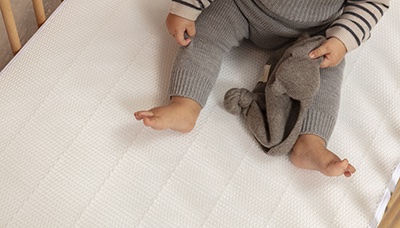Does your little one often struggle during or after feedings? Colic symptoms, gas or reflux: it can be hard to know what's bothering your crying baby. First of all, good news: infant colic usually stops by the time your little one is 3 to 4 months old. So hang in there, dear baby and parents!
Of course, as parents, your baby's cry hurts your heart and comforting your baby is all you want to do. So do you have a colicky baby? We'll go over some things you can do to help calm your baby's tummy and help your little one stop crying.
What can I do during feedings?
Burp your baby during feeds
Many babies swallow air while drinking milk, whether they are breast- or bottle-fed. Perhaps the milk flowed too fast or air got into your baby's formula. If a baby burps smoothly, that's not a problem. But in some babies, the trapped air doesn't go away as easily, which can cause discomfort.
Most parents let their baby burp after feeding. But if your baby is experiencing a lot of discomfort, make sure to burp your baby during feeding as well. This prevents air from building up in your little one's stomach. For example, take a break halfway through the bottle, or for breastfeeding when switching breasts.
How to burp my baby?
- Place a muslin cloth over your shoulder.
- Hold your baby against your torso, arms and head above your shoulder.
- Give a few pats on the back, and hopefully a burp will emerge soon!
- You can walk around the room while holding your baby like this. The rhythm of your steps helps to both calm your baby and to let the air come up.
Feeding your baby in an inclined position
If you are bottle-feeding (formula or pumped breast milk), you can try to make sure that your child sits up a little while drinking. If your baby doesn't like lying in the corner of your arms, you can try letting them drink in a baby seat or recliner. You can also try to give your baby smaller meals, a different bottle or slower teat to see if it makes a difference.
Even with breastfed babies, there are different feeding positions to make sure your baby takes in as little air as possible. Can't seem to figure it out? Then it may help to contact a lactation consultant (IBCLC).
Note: some babies don't like inclined feeding at all. You don't have to force it, make sure to keep your baby upright after the feeding.


What can I do after the feeding?
Burp well after the feed
After the feeding, take some time to burp your baby. If putting your baby over your shoulder doesn't work, you might try moving your little one up and down on your knee or over your forearm.
Or try it on your lap. Put your baby on your lap with their face away from you. Place the palm of your hand flat against the breast and support the head very gently under the chin. Bend your baby slightly forward and gently pat or rub its back with your free hand. Do you hear a burp? Score!
You can also visit a baby osteopath and ask them to teach you some tricks to help your baby burp more easily.
Holding your baby upright after feeding to prevent acid regurgitation
After feeding, don't put your baby down right away, but hold them upright for a while. It is okay to take some time for this. Some babies burp immediately after feeding, others take longer.


My baby spits up a lot (reflux)
Between the end of the esophagus and the entrance to the stomach is a sphincter muscle. This sphincter opens to let food into the stomach. Then it closes again to keep the food and acidic gastric juice in the stomach and protect the esophagus. In the early stages of a baby's life, the sphincter between the stomach and esophagus is often not yet fully developed, which is why many babies have reflux.
We speak of common reflux or uncomplicated reflux when your baby regularly spits up, but is otherwise unbothered by it. If babies gain weight well, eat well and seem content, everything is A-okay. In most babies, reflux disappears almost entirely during the first year.
With silent reflux, your baby's stomach contents also come up, but not out. The milk and stomach acid only reach the esophagus, which is called acid regurgitation or heartburn. You can compare it to heartburn in yourself. Over time, your baby's esophagus can become irritated and inflamed from the acidic gastric juice.
Signs and symptoms of reflux in babies
If reflux (silent or otherwise) causes severe symptoms, it is called reflux disease. If your baby has reflux disease, you probably notice your baby is not doing well. All babies cry and it's normal that a healthy baby cries, but crying may become worrisome if it's intense crying accompanied by other symptoms such as: not sleeping wel, being irritable, feeding problems, not gaining weight well... If you suspect that your baby has reflux disease, you should consult your family doctor or pediatrician. Still, there are some things you can do to make your baby a little more comfortable, such as keeping them upright a lot (in a baby carrier, for example) and letting them sleep inclined.
Tips for dealing with reflux (acid regurgitation)
Does your baby often spit up or do you notice that your little one really doesn't like lying down right after feeding? During the day, it can be helpful to keep your little one upright for at least half an hour after feeding. If your little one is in a lot of discomfort because of reflux, it may even help to keep your infant upright as much as possible during the day and a nice baby carrier can be a useful aid. This way the esophagus gets a rest and your baby can better tolerate lying flat at night. At night, it can help to sleep inclined, we'll tell you all about that later on in this article.
The symptoms of colic may include inconsolable crying (often for hours a day), restlessness, overstretching, gassiness and flailing with arms and legs. Colic symptoms often start about the same time every day. Infantile colic usually starts when a baby is a few weeks old and peaks when the baby is between 4 and 6 weeks old. It's not entirely clear what causes colic, but it's most likely linked to your little one's digestive system that is not yet fully developed. Colicky crying is most common in babies up to 3 months and eventually goes away on its own.
If you think your baby is suffering from colic symptoms and belly pain, you can help your baby let out wind. Lay your baby on its back and make cycling movements with those cute little legs. Very gently, up, down. You might be rewarded with a little fart. You can give your baby a soothing tummy massage: stroke gently from the neck down. You can also apply light pressure to the tummy. A warm bath can also provide some relief for your fussy baby.
What can I do to help my colicky baby or reflux baby sleep?
Letting your baby sleep safely inclined and swaddled can provide relief from tummy cramps and reflux. We're happy to tell you all about it!
lnclined sleeping
The gastric valve of many newborns does not yet close properly, which can be compared to a water bottle whose cap does not fit properly. If you lay that bottle down flat, everything runs out again. But if you put the bottle on an incline, gravity causes the liquid to stay in place. The same principle applies to the stomach. By letting your baby sleep on an incline, you can let gravity work in your favor. Keeping upright after feeding is great advice, but it can be very tiring at night. That's why an inclined mattress can help. Simple, but effective!
Inclined sleeping can help against intestinal cramps. The safest and best solution for this is an inclined mattress, because it creates a natural slope that supports the back and neck.
You can put the AeroSleep Premium mattress in both a flat and an inclined position, depending on what's the best solution for your little one at that moment. Moreover, the mattress protector with AeroSleep 3D technology ensures that your baby always sleeps on a safe, hygienic and dry mattress, can breathe well and does not overheat. The more discomforts you can address at once, the better!
Inclined sleeping remains useful when your little one gets a little older and no longer suffers from cramps or reflux. Inclined sleeping can also provide relief for other typical baby ailments such as colds, fever, flu, teething or earaches.


How do I let my baby sleep inclined safely?
It may be tempting to incline your child's bed by sliding something under the legs, but it is very important that the slope of the mattress is not too steep and that your baby's sleep setup is safe. In fact, if the slope is too steep, your child may roll to the foot end. An anti-reflux pillow only partially raises the mattress, and bed blocks are not recommended by most crib manufacturers for safety reasons.
You can easily convert AeroSleep's PREMIUM mattresses into a sloping mattress yourself. The ideal inclination of 7° promotes digestion and provides relief. Because not only the head end is raised in the process, a more natural slope is created. The mattress supports your little one's neck and back and stimulates free breathing.


Swaddling
Swaddling can also help soothe your baby and help them sleep more peacefully. This technique has been used for centuries and with today's knowledge, we can make swaddling extra safe, cozy and easy.
How can I safely swaddle my baby?
Sleeping in a swaddle sleeping bag, such as those made by Puckababy, is a mild form of the traditional tight swaddling with cloths. The Puckababy Piep wraps around your baby like an airy cocoon, not too tight, and is heat regulating. It provides much-needed security, so your baby calms down more easily and sleeps deeper. Good sleep, in turn, helps process stimuli and relieve intestinal cramps or other discomfort. The tummy strap inside the Piep keeps your baby safely in place, and your baby gets extra tummy relief thanks to the light pressure.


A baby hammock to soothe baby colic
Being a newborn baby comes with its share of discomforts. Not all babies suffer equally, but what helps many babies is distraction through movement. A baby feels soothed and calmed by rocking movements, just like in mom's tummy. Some colicky babies are soothed by an infant swing or vibrating seat. Even better than that: a luxurious baby hammock to lull your baby into a wonderful sleep. Unlike your arms, the motor of the hammock never gets tired and can rock your baby for hours a day...
When to go to the doctor with colicky babies?
Note: this article provides general tips. If your baby cries for hours a day (excessive crying) and you feel like your baby's crying has underlying causes, it's time to contact your baby's healthcare provider and get help.
Still have questions?
We're here for you!







